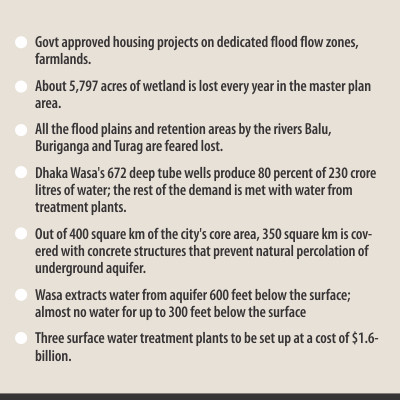The city dwellers will have to face a severe water supply and drainage crisis in near future unless the wholesale destruction of flood plains and wetlands ceases immediately, experts have warned.
“We are definitely heading towards a disaster in terms of availability of safe water and a good drainage system as the rivers around the capital are already polluted beyond treatment and choked up because of land grabbing,” said Country Representative Md Khairul Islam of WaterAid Bangladesh.
In June last year, the government gave the go-ahead to three housing schemes — Jolshiri, Protyasha and Bashundhara Residential Area (partial) — to be implemented on flood flow zones, said Rajuk sources.
Just around two months later, the housing and public works ministry approved some private housing projects that led to destruction of over 8,000 acres of flood flow zones and farmland.
Khairul said 672 deep tube wells of Dhaka Water Supply and Sewerage Authority (Wasa) currently produce 80 percent of 230 crore litres water to meet the capital’s daily demand while it supplies the rest from water treatment plants.
That apart, Dhaka University, Pilkhana headquarters of Boarder Guard Bangladesh, Dhaka Cantonment and some private individuals meet their demand independently by using over 2,000 deep tube wells, he added.
Wetlands and flood plains are vital rainwater catchment areas to recharge ground water. They also contain surface water and check urban flash floods caused by monsoon downpours, said the WaterAid official.

Indian cities like Mumbai, Pune and Kolkata survive simultaneously on ground water and rainwater harvesting, mentioned Khairul.
Sarmin Sultana, an assistant professor of geology at Dhaka University, said wetlands and water retention areas contain rainwater for months and help natural percolation of water as the water gets clean in the process of permeation.
Flood plains, water bodies, retention areas and open spaces together constitute one third of the 1525-square km master plan area of Dhaka. But according to an unofficial estimate, influential realtors have so far destroyed over 80 percent of conservable wetlands by filling them with earth and building concrete structures, with approval from the government in some cases.
Dr Ishrat Islam of Buet’s urban and regional planning department said around 5,797 acres of wetland is lost every year in the master plan area.
Khondaker M Ansar Hossain, one of the planners of Detailed Area Plan (DAP) of Dhaka, said satellite images show that flood plains in Kashipmur of Gazipur and water retention areas by the river Buriganga in Mohammadpur have been ruined.
Similarly, flood plains by the river Balu in Rupganj, water retention areas by the same river in Beraid and Kahetpara and flood plains and retention areas by the rivers Buriganga and Turag in Ashulia and Savar have been destroyed.
Dhaka Wasa Managing Director Taqsem A Khan said out of 400 square km of the city’s core area, 350 square km is covered with concrete structures that prevent natural percolation of underground aquifer.
Currently, the Wasa extracts water from underground aquifer 600 feet below the surface. There is almost no water for up to 300 feet below the surface of the ground due to excessive mining. The water table in the core city area is depleting by one to three metres a year, he added.
Taqsem said as the freshwater reserve of aquifer is depleting fast and the water of the Buriganga, Turag, Balu and Shitalakhya has become untreatable, the Wasa is planning to implement three mega projects involving $1.6 billion to set up three surface water treatment plants with foreign loan.
The plants will be built on the fringes of the city to treat water from the Padma and Meghna rivers and meet 70 percent of the capital’s total demand for water by 2020, he noted.
Khondaker Ansar Hossain said the Wasa’s idea is unrealistic because it would be quite expensive to pipe in drinking water from rivers around 20 to 30 km away.
Eminent climate change expert Dr A Atiq Rahman said the national water policy specifies a balanced use of surface and ground water as a viable solution to the problem which requires adequate ground water recharge.
Life in the capital comes to a grinding halt almost every time there is usual monsoon rain, thanks to poor drainage. Streets and alleyways are flooded and traffic situation becomes a nightmare.
Leading experts have cautioned that the city would see much bigger disasters in future unless the dedicated flood plains, water retention areas and canals are reclaimed on a war footing.
Source: New Age










